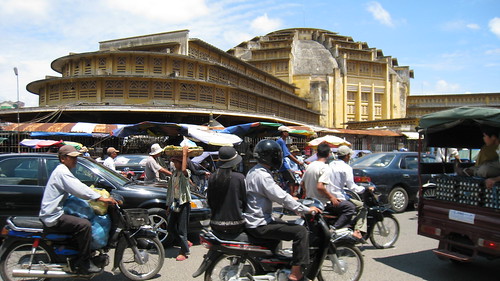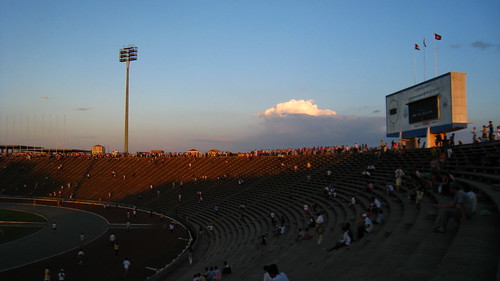 Until Phnom Penh I had not been in a city in South-East Asia that I felt was distinctly unpleasant. Phnom Penh has a lot of negative South-East Asian characteristics and it seems to have them in such an abundance. The traffic is incesant and chaotic, motos drivers yell at you, people hassle you to buy things and its hot and humid. I felt a degree of culture shock in Phnom Penh that I had not yet felt on my travels. I think my month in Laos had got me used to a relaxed pace of life, and Cambodia outside of Phnom Penh is also relaxed (maybe not Siem Reap). Nothing bad happened to me while I was there and while there felt like a dodgy atmosphere I never felt in any danger. The only reason I can suggest visiting Phnom Penh is to go to Tuol Sleng and the Killing Fields.
Until Phnom Penh I had not been in a city in South-East Asia that I felt was distinctly unpleasant. Phnom Penh has a lot of negative South-East Asian characteristics and it seems to have them in such an abundance. The traffic is incesant and chaotic, motos drivers yell at you, people hassle you to buy things and its hot and humid. I felt a degree of culture shock in Phnom Penh that I had not yet felt on my travels. I think my month in Laos had got me used to a relaxed pace of life, and Cambodia outside of Phnom Penh is also relaxed (maybe not Siem Reap). Nothing bad happened to me while I was there and while there felt like a dodgy atmosphere I never felt in any danger. The only reason I can suggest visiting Phnom Penh is to go to Tuol Sleng and the Killing Fields.
There are positive aspects to Phnom Penh. There is some impressive French architecture hanging around and some local efforts pre-dating the Khmer Rouge era. The Royal Palace and Silver Pagode are beautiful and worth visiting. The National Museum is a beautiful building and a good place to escape the chaos of Phnom Penh. I was sitting in the courtyard and chatted to a couple of guys from the countryside. One of whom wanted to be a politician and use his love of karate, Bruce Lee and Jackie Chan, as a political philosophy. The nicest place in Phnom Penh was the National Stadium. I chanced upon it wandering through the streets from Tuol Sleng. There was a big crowd of people outside and I wondered what was going on. On my way in I noticed that there were badminton games taking place in any space available. It turned out there a football game being played. Two Cambodians came over to chat with me to practice their English. I wanted to know who was playing but it turned out they were not interested in the game. They were there for aerobics. Sure enough once the game finished the crowd that had developed spread itself around the top of the stadium, and with speakers hooked up, several different aerobics classes began. Cambodians, Thais, and Laos, really enjoy their aerobics. In the late afternoon you often hear a techno beat coming from somewhere and when you go and investigate you dicsover lots of middle-aged women jumping and punching in unison. They take place in any public space, often along the riverside. In Vientaine (Laos) a particularly popular spot is next to the Mekong in the centre of town. Aerobics isn't necessarily seen as that taxing but these South-East Asian women can really move. In Vietaine Western men tried to take part, within five minutes they were out of synch with everyone else and within ten minutes they were taking a seat on the bench. While I had seen aerobics in alot of places I hadn't seen quite so many people in one place doing it before. There was a great atmosphere all around the national stadium. I would recommend taking a walk over there if you want to see Phnom Penh residents enjoying themselves.
 Tuol Slenh is without doubt the most important place to visit in Phnom Penh, if not Cambodia. While walking around Tuol Sleng is chilling, the walls of faces, the photographs of the state the Vietnamese found the prison, the tiny cells where people were kept, the paintings of what the tortures inflcited on people, and the cabinets full of skulls from the Killing Fields. The true horror of what was done there does not come across without reading David Chandler's "Voices from S-21". S-21 was the codename for Tuol Sleng. Tuol Sleng was a school that the Khmer Rouge used as a torture and interrogation facility. "S-21 was a total instituion whose mission was to locate, question, and destroy the enemies of the Party Centre" (Chandler). Once the interrogators had achieved acceptable 'confessions' the prisoner would be taken to the Killing Fields where they would be clubbed over the head and thrown in a mass grave. 14,000 people, men, women and children, were killed at S-21. The confessions were used as a tool to gather more suspects to be interrogated and killed. Innocent people being wrongly detained and killed was acceptable according to a DK adage "It is better to arrest 10 people by mistake than to let one guilty person go free" (Chandler). Chandler deals with how prisoners once arrested were guilty. The interrogator may not know why they were arrested but the fact of the arrest meant they must have committed a crime. Violence during interrogation was commonplace. Chandler quotes a Duch directive to the interrogators and guard, "You must rid yourself of the view that beating the prisoners is cruel. Kindneess is misplaced. You must beat (them) for national reasons, class reasons, and international reasons". Duch was the head of S-21 who is currently on trial for war crimes. Click here for an article on the BBC News website about his trial. Tuol Sleng was discovered by Vietnamese troops when they captured Phnom Penh. They were drawn there by the smell of rotting bodies. When they arrived they found bodies still strapped to bed frames in cells. The Vietnamese preserved Toul Sleng as a testament to the crimes of the Khmer Rouge. Chandler states, "the history that he (Mai Lam Vietnamese Colonel fluent in Khmer, had constructed Museum of American War Crimes in Ho Chi Minh City) constructed in the exhibits at S-21 denied the leaders of the CPK any socialist credentials and encouraged viewers to make connections between the Democratic Kampuchea regime and Tuol Sleng on the one hand, and Nazi Germany...on the other". I found the most disturbing part of Tuol Sleng were the walls of photographs of prisoners. The prisoners were photographed when they arrived, and if they were important, when they died.
Tuol Slenh is without doubt the most important place to visit in Phnom Penh, if not Cambodia. While walking around Tuol Sleng is chilling, the walls of faces, the photographs of the state the Vietnamese found the prison, the tiny cells where people were kept, the paintings of what the tortures inflcited on people, and the cabinets full of skulls from the Killing Fields. The true horror of what was done there does not come across without reading David Chandler's "Voices from S-21". S-21 was the codename for Tuol Sleng. Tuol Sleng was a school that the Khmer Rouge used as a torture and interrogation facility. "S-21 was a total instituion whose mission was to locate, question, and destroy the enemies of the Party Centre" (Chandler). Once the interrogators had achieved acceptable 'confessions' the prisoner would be taken to the Killing Fields where they would be clubbed over the head and thrown in a mass grave. 14,000 people, men, women and children, were killed at S-21. The confessions were used as a tool to gather more suspects to be interrogated and killed. Innocent people being wrongly detained and killed was acceptable according to a DK adage "It is better to arrest 10 people by mistake than to let one guilty person go free" (Chandler). Chandler deals with how prisoners once arrested were guilty. The interrogator may not know why they were arrested but the fact of the arrest meant they must have committed a crime. Violence during interrogation was commonplace. Chandler quotes a Duch directive to the interrogators and guard, "You must rid yourself of the view that beating the prisoners is cruel. Kindneess is misplaced. You must beat (them) for national reasons, class reasons, and international reasons". Duch was the head of S-21 who is currently on trial for war crimes. Click here for an article on the BBC News website about his trial. Tuol Sleng was discovered by Vietnamese troops when they captured Phnom Penh. They were drawn there by the smell of rotting bodies. When they arrived they found bodies still strapped to bed frames in cells. The Vietnamese preserved Toul Sleng as a testament to the crimes of the Khmer Rouge. Chandler states, "the history that he (Mai Lam Vietnamese Colonel fluent in Khmer, had constructed Museum of American War Crimes in Ho Chi Minh City) constructed in the exhibits at S-21 denied the leaders of the CPK any socialist credentials and encouraged viewers to make connections between the Democratic Kampuchea regime and Tuol Sleng on the one hand, and Nazi Germany...on the other". I found the most disturbing part of Tuol Sleng were the walls of photographs of prisoners. The prisoners were photographed when they arrived, and if they were important, when they died. I stayed at Angkor Meas Guesthouse in Phnom Penh. $5 for cold ensuite, fan, single bed, and TV. It was the worst room I had in Cambodia (other than the Golden Parrot in Battambang) although it wasn't too bad. I stayed there because I could not find any cheap (ie $5 rooms) in Phnom Penh, it seems rooms are unsurisingly more expensive in the capital. Angkor Meas is at 112 Street 19, Songkat Phsar Kandal 2. It sits in the maxe of backstreets. The easiest way to find it is to go to the road along the riverfront, find Kiwi Bakery and Restaurant, walk south and then take your first right, keep walking straight until on your right is a Sports Cafe at this junction turn left and Angkor Meas is on your left.
I got my Vietnam Visa in Phnom Penh. I hired a tuk-tuk to the Vietnam Embassy and it cost $3 including wait time outside before taking me back to the centre of town. The 30 day tourist visa cost $35 (British passport holder) and I was able to collect it the next day. In hindsight I should have got a 90 day visa if I had known that I would need it to get a Russian visa in Vietnam.
No comments:
Post a Comment